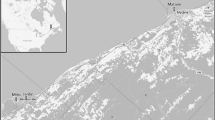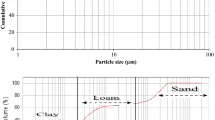Abstract
Currently, the contamination by lead has become a serious issue to the environment, and many approaches are continuously been searched for its removal from the environment. In the present study, the adsorption potential and interaction of lead [Pb(II)] with natural clay and humic acid were investigated. X-ray diffraction analysis revealed quartz as a dominant mineral in natural clay. Maximum adsorption capacity of both natural clay and humic acid for Pb(II) was 25.07 and 19.16 mg/g, respectively, after the incubation time of 180 min and adsorbate and adsorbent concentrations of 20 mg/L and 10 g/L, respectively. Adsorption capacity of clay was found to be 1.3-folds greater than that of humic acid. Pb(II) adsorption on clay and humic acid was according to the Langmuir isotherm and followed the pseudo-second-order and intraparticle diffusion model kinetics. Fourier transform infrared spectra revealed that Si–O–Si and OH− groups in clay were involved in the interaction with Pb(II); and carboxylic acid, phenolic and alcoholic groups and alkyl halides in humic acid were involved in the interaction with Pb(II). Scanning electron microscopy and energy-dispersive X-ray spectra analysis revealed that Pb(II) adsorption on clay and humic acid occurred by replacement of Mg and Al ions, potentially by ion exchange mechanism. Overall, the results concluded that natural clay and humic acid are promising adsorbents for limiting the mobility of Pb(II) ions in the soil system and aquatic environment, and this could be an effective method for lead waste management.





Similar content being viewed by others
References
Akpomie GK, Ogbu IC, Osunkunle AA, Abuh MA, Abonyi MN (2012) Equilibrium isotherm studies on the sorption of Pb(II) from solution by Ehandiagu clay. J Emerg Trends Engg Appl Sci 3:354–358
Alban LA, Kellogg M (1959) Methods of soil analysis as used in the OSC Soil Testing Laboratory. Agricultural experiment station. Oregon State College, Corvallis
Anna B, Kleopas M, Constantine S, Anestis F, Maria B (2015) Adsorption of Cd (II), Cu (II), Ni (II) and Pb(II) onto natural bentonite: study in mono-and multi-metal systems. Environ Earth Sci 73:5435–5444
Arul Manikandan N, Alemu AK, Goswami L, Pakshirajan K, Pugazhenthi G (2016) Waste litchi peels for cr (vi) removal from synthetic wastewater in batch and continuous systems: sorbent characterization, regeneration and reuse study. J Environ Eng 142:C4016001
Baker H, Khalili F (2004) Analysis of the removal of lead (II) from aqueous solutions by adsorption onto insolubilized humic acid: temperature and pH dependence. Anal Chim Acta 516:179–186
Bhattacharyya KG, Gupta SS (2006) Pb(II) uptake by kaolinite and montmorillonite in aqueous medium: influence of acid activation of the clays. Colloids Surf A Physicochem Eng Asp 277:191–200
Bind A, Goswami L, Prakash V (2018) Comparative analysis of floating and submerged macrophytes for heavy metal (copper, chromium, arsenic and lead) removal: sorbent preparation, characterization, regeneration and cost estimation. Geol Ecol Landscapes 2:61–72
Borisov SN (2012) Organosilicon heteropolymers and heterocompounds. Springer, Berlin
Businelli M, Casciari F, Businelli D, Gigliotti G (2003) Mechanisms of Pb(II) sorption and desorption at some clays and goethite-water interfaces. Agronomie 23(3):219–225
Chandrasekaran A, Ravisankar R, Rajalakshmi A, Eswaran P, Anand DP (2013) FT-IR spectroscopy investigation of soils from Yelagiri Hills, Tamil Nadu India. Sci Acta Xaveriana 4:29–40
Chrysochoou M, Puppala A, Chittoori B (2012) Characterization of clays using quantitative xrd and chemical analyses. In: GeoCongress 2012: state of the art and practice in geotechnical engineering, pp 1165–1174
Dawodu FA, Akpomie GK, Ogbu IC (2012) Isotherm modeling on the equilibrium sorption of cadmium(II) from solution by Agbani clay. Int J Multidiscip Sci Eng 3:9–14
Drweesh SA, Fathy NA, Wahba MA, Hanna AA, Akarish AIM, Elzahany EAM, EI-Sherif IY, Abou-EI-Sherbini KS (2016) Equilibrium, kinetic and thermodynamic studies of Pb(II) adsorption from aqueous solutions on HCl-treated Egyptian kaolin. J Environ Chem Eng 4:1674–1684
Eloussaief M, Sdiri A, Benzina M (2013) Modelling the adsorption of mercury onto natural and aluminium pillared clays. Environ Sci Pollut Res 20:469–479
Erdogan S, Baysal A, Akba O, Hamamci C (2007) Interaction of metals with humic acid isolated from oxidized coal. Pol J Environ Stud 16:671–675
Fathy NA, El-Sherif IY (2011) Equilibrium removal of Pb(II) ions from aqueous solution onto oxidized-KOH-activated carbons. Carbon Lett 12:1–7
Goswami L, Manikandan NA, Pakshirajan K, Pugazhenthi G (2017) Simultaneous heavy metal removal and anthracene biodegradation by the oleaginous bacteria Rhodococcus opacus. 3 Biotech 7:37
Gupta SS, Bhattacharyya KG (2009) Treatment of water contaminated with Pb(II) and Cd(II) by adsorption on kaolinite, montmorillonite and their acid-activated forms. Indian J Chem Technol 16:457–470
Jasim HS, Idris M, Abdullah A, Kadhum AAH (2014) Effects of physicochemical soil properties on the heavy metal concentrations of Diplaziumesculentum (medicinal plant) from the UKM and Tasik Chini, Malaysia. Int J Chemtech Res 6:5519–5527
Jordão CP, Reis C, Bellato CR, Jham GN, Pereira JL (2001) Adsorption of Cu2 + ions on Has. Rem Revista Escola de Minas 54:109–114
Khan T, Isa MH, Mustafa MRU, Yeek-Chia H, Baloo L, Masnan TSBA, Saeed MO (2016) Cr (VI) adsorption from aqueous solution by an agricultural waste based carbon. RSC Adv 6:56365–56374
Klučáková M, Pavlíková M (2017) Lignitic humic acid as environmentally-friendly adsorbent for heavy metals. J Chem. https://doi.org/10.1155/2017/7169019
Kushwaha A, Rani R, Kumar S, Gautam A (2015) Heavy metal detoxification and tolerance mechanisms in plants: implications for phytoremediation. Environ Rev 24:39–51
Kushwaha A, Rani R, Kumar S, Thomas T, David AA, Ahmed M (2017) A new insight to adsorption and accumulation of high lead concentration by exopolymer and whole cells of lead-resistant bacterium Acinetobacter junii L. Pb1 isolated from coal mine dump. Environ Sci Pollut Res 24:10652–10661
Kushwaha A, Hans N, Kumar S, Rani R (2018) A critical review on speciation, mobilization and toxicity of lead in soil-microbe-plant system and bioremediation strategies. Ecotoxicol Environ Saf 147:035–1045
Laride WA (2015) Infrared spectra of humic acid and metal humates precipitated from groundwater. J Water Resour Hydraul Eng 4:105–110
Liu B, Lv X, Meng X, Yu G, Wang D (2013) Removal of Pb(II) from aqueous solution using dithiocarbamate modified chitosan beads with Pb(II) as imprinted ions. Chem Eng J 220:412–419
Maharana JK, Patel AK (2013) Characterization of physicochemical properties and their impact on enzyme activities in a chronosequence coal mine overburden spoil as biomarker for reclamation process. J Bacteriol Parasitol 4:174–183
Manunza B, Deiana S, Maddau V, Gessa C, Seeber R (1995) Stability constants of metal-humate complexes: titration data analyzed by bimodal Gaussian distribution. Soil Sci Soc Am J 59:1570–1574
Mbadcam JK, Anagho SG, Nsami JN (2011) Kinetic and equilibrium studies of the adsorption of lead(II) ions from aqueous solution onto two Cameroon clays: kaolinite and smectite. J Environ Chem Ecotoxicol 3:290–297
Pehlivan E, Arslan G (2006) Uptake of metal ions on humic acids. Energy Sources Part A 28:1099–1112
Santos AMP, Bertoli AC, Borges AP, Gomes RAB, Garcia JS, Trevisan MG (2018) New organomineral complex from humic substances extracted from poultry wastes: synthesis, characterization and controlled release study. J Braz Chem Soc 29:140–150
Sdiri A, Higashi T, Chaabouni R, Jamoussi F (2012) Competitive removal of heavy metals from aqueous solutions by montmorillonitic and calcareous clays. Water Air Soil Pollut 223:1191–1204
Shahat A, Awual MR, Khaleque MA, Alam MZ, Naushad M, Chowdhury AS (2015) Large-pore diameter nano-adsorbent and its application for rapid lead(II) detection and removal from aqueous media. Chem Eng J 273:286–295
Shahmohammadi-Kalalagh S (2011) Isotherm and kinetic studies on adsorption of Pb, Zn and Cu by kaolinite. Caspian J Environ Sci 9:243–255
Sharifipour F, Hojati S, Landi A Faz, Cano A (2015) Kinetics and thermodynamics of lead adsorption from aqueous solutions onto Iranian sepiolite and zeolite. Int J Environ Res 9:1001–1010
Sidhu P, Gilkes RJ (1977) Mineralogy of soils developed on alluvium in the Indo-Gangetic plain (India). Soil Sci Soc Am J 4:1194–1201
Singh PK, Kushwaha A, Hans N, Gautam A, Rani R (2019) Evaluation of the cytotoxicity and interaction of lead with lead resistant bacterium Acinetobacter junii Pb1. Braz J Microbiol 50:223–230
Srinivasan R (2011) Advances in application of natural clay and its composites in removal of biological, organic, and inorganic contaminants from drinking water. Adv Mater Sci Eng 2011:17
Srivastava P, Pal DK, Aruche M, Wani SP, Sahrawat KL (2015) Soils of the Indo-Gangetic alluvial plains: historical perspective, soil-geomorphology and pedology in response to climate change and neotectonics. Earth-Sci Rev 140:54–71
Uddin MK (2017) A review on the adsorption of heavy metals by clay minerals, with special focus on the past decade. Chem Eng J 308:438–462
Udvardi B, Kovács IJ, Fancsik T, Kónya P, Bátori M, Stercel F, Falus G, Szalai Z (2017) Effects of particle size on the attenuated total reflection spectrum of minerals. Appl Spectrosc 71:1157–1168
Van der Marel HW, Beutelspacher H (1976) Atlas of infrared spectroscopy of clay minerals and their admixtures. Elsevier, Amsterdam
Wang Z, Cao M, Cai W, Zeng H (2017) The effect of humic acid and fulvic acid on adsorption-desorption behavior of copper and zinc in the yellow soil. AIP Conf Proc 1820:040027
Wu M, Song M, Liu M, Jiang C, Li Z (2016) Fungicidal activities of soil humic/fulvic acids as related to their chemical structures in greenhouse vegetable fields with cultivation chronosequence. Sci Rep 6:32858
Xing B, Chen Z (1999) Spectroscopic evidence for condensed domains in soil organic matter. Soil Sci 164:40–47
Yin J, Deng C, Yu Z, Wang X, Xu G (2018) Effective removal of lead ions from aqueous solution using nano illite/smectite clay: isotherm, kinetic, and thermodynamic modeling of adsorption. Water 10(2):210
Acknowledgements
Authors are highly thankful to MNNIT, Allahabad, and TEQIP-II (NPIU/TEQIP-II/FIN/37) for financial support. A.K acknowledges TEQIP-II for providing research fellowship. Authors acknowledge the CIR, MNNIT, Allahabad, SAIF, Panjab University, Chandigarh, and SAIF, IIT, Kanpur, India, for XRD, FTIR and SEM–EDS analyses, respectively.
Funding
This study is funded by TEQIP-II (NPIU/TEQIP-II/FIN/37).
Author information
Authors and Affiliations
Corresponding author
Ethics declarations
Conflict of interest
The authors declare no conflict of interest.
Ethical approval
This article does not contain any studies with animals performed by any of the authors.
Additional information
Editorial responsibility: Rupali Datta.
Electronic supplementary material
Below is the link to the electronic supplementary material.
Rights and permissions
About this article
Cite this article
Kushwaha, A., Rani, R. & Patra, J.K. Adsorption kinetics and molecular interactions of lead [Pb(II)] with natural clay and humic acid. Int. J. Environ. Sci. Technol. 17, 1325–1336 (2020). https://doi.org/10.1007/s13762-019-02411-6
Received:
Revised:
Accepted:
Published:
Issue Date:
DOI: https://doi.org/10.1007/s13762-019-02411-6




